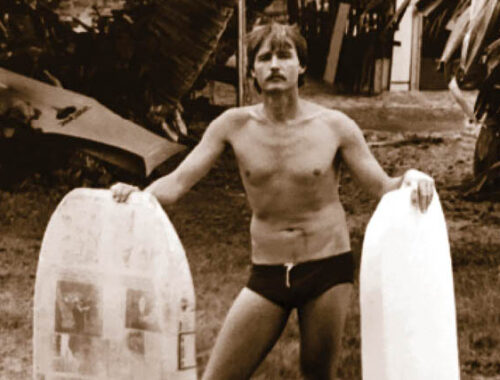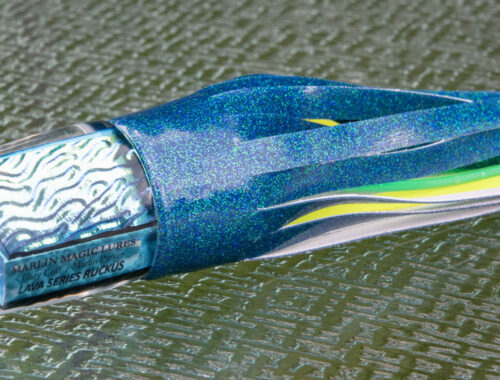
Hawaiian Petroglyphs Tell Stories of the Past
 By Margaret Kearns
By Margaret Kearns
K‘i‘i pōhaku – the name Hawaiians gave their petroglyphs – are found scattered throughout the island chain. The largest, most concentrated fields of ancient rock carvings, however, are found here on Hawai‘i Island, where smooth, pahoehoe lava rock provided an ideal “canvas” on which to create k’i’i pōhaku over the massive lava flows, cliff faces and the smooth interiors of lava tubes and coastal caves.
One of the most accessible, viewer-friendly fields here, according to researcher and author, Ski Kwaiatkowski, is found surrounded by shopping center and condominium developments at Waikoloa Beach Resort on the island’s west coast.
While Kwaiatkowski, a native of O‘ahu of Hawaiian, Portuguese and Polish descent, has been studying petroglyphs for more than 40 years, he became a serious student of the Waikoloa petroglyph fields when he moved to Hawai‘i Island in the early 1980s.
“Early on I was lucky to talk with some old-time Hawaiians about the k‘i‘i pōhaku—kūpuna [elders] who are now long-gone from this earth, whose stories fueled my interest in the subject,” he says.
By 1983, Kwaiatkowski was giving guided walks on the five-to six-acre Waikoloa field during “off-time” from his chief-of-security duties at the nearby Royal Waikoloan Resort (now the Marriott Waikoloa Beach Resort). In 1991, his book Na K‘i‘i Pōhaku: The Hawaiian Petroglyph Primer was published. “It’s now out of print, but we’ve learned so much since it was published more than 20 years ago, I’m planning to update it and come out with a second printing,” Kwaiatkowski says.
Among the most significant new findings—information that was not scientifically proven in 1991—is the age of the rock carvings found along the Ala Loa Trail (more commonly known as the King’s Trail) at Waikoloa. Using carbon-14 dating, Professors Ron Dorn and Nicole Cerveny of Arizona State University’s Geology Department have determined the oldest petroglyph in the Waikoloa field was created in 840 AD and the most recent in 1900, according to Kwaiatkowski.
“I believe petroglyph-making remained active and wide-spread in the islands just prior to the arrival of Captain Cook. For some unknown reason, after the arrival of Cook and all those other guys [early explorers], it died off relatively quickly,” he says.
What we do know, he said, through both scientific carbon dating and distinctive carving styles, is the progression of more and more sophisticated art forms, the earliest being linear stick-man drawings, which then moved to a brief period of block-like, wide-bodied forms. Both of these styles, Kwaiatkowski says, are found used by ancient cultures worldwide. The most recent pre-contact drawings use triangular forms unique to the Hawaiian k‘i‘i pōhaku.
“Post-contact drawings are perhaps the easiest to recognize, since they often depict large sailing ships, muskets and cattle,” he says.
All of these forms—from most primitive to most recent—are found at the Waikoloa field, and among the most rare petroglyphs found here are a spiral (a symbol almost never found in Hawai‘i); an image of Lono, guardian of agriculture and the clouds; a feather cape, and a horse and rider (paniolo or Hawaiian cowboy) of distinctly Mexican nationality, as signaled by the sombrero atop his head!
“Between about the 1840s and 1850s, Hawai‘i Island was being over-run by wild cattle introduced by the Europeans and Mexican charros [cowboys] who were brought over to share their herding, rounding-up and roping skills with the native Hawaiians,” Kwaiatkowski says.
Respected cultural leader and kahu (shepherd or minister) Danny Akaka says each of the drawings found here are significant in their own way. “We can only speculate about the meaning of many of the petroglyphs.”
Although there has not been an official count, Kwaiatkowski and Akaka agree that the Waikoloa field may contain up to 10,000 petroglyphs, making it the most densely concentrated area on the island.
With Hawai‘i Island’s large landmass—most of it conducive to rock carving—one wonders why so much of it is petroglyphy-free while relatively small areas are densely covered?“
Hawaiian are very sensitive to places with high energy or areas with ‘power spots,’ containing special mana [power]…this is where the highest concentration of k‘i‘i pōhaku are found,” Akaka says.
Many of these areas of dense concentration, such as the Waikoloa field, are theme specific, he says. “For example, the nearby petroglyph field at Mauna Lani Resort is devoted primarily to rock drawings depicting procreation and ‘ohana [family] life, the most prominent feature of the Waikoloa field is birth and the piko [umbilical cord] ceremonies that were held here.”
Kwaiatkowski explains, the piko ceremony consisted of taking a remnant of the baby’s umbilical cord and placing it in a sacred hole at this site overnight to absorb the mana. “The family returned the next morning to retrieve the remnant. There was a downside, however. If the remnant was missing, it was thought to have been taken by a rat [considered a thief by Hawaiians], and the characteristics of that unsavory character were absorbed instead.
“Fortunately the concept of hānai [adopted] children was common back in the day, and often families would give away a child—no questions asked—to a friend or relative to raise,” he says. This was often the fate of these so-called “rat children”—not such a bad fate at all!
Today, docents are at the Waikoloa field site daily from about 7 a.m. to 6 p.m., spreading aloha and educating visitors about this powerful petroglyph site. To access the site, park at the east or mauka (towards the mountains) end of the Kings’ Shopping Center parking lot and follow the rock path behind the service station into the lava fields.
Some Viewing Tips and Warnings:
For optimal viewing of the k’i’i pōhaku at Waikoloa Beach Resort—or any of the Hawaiian Islands’ sites—arrive just after dawn or just before dusk. The angle of the sun at these times best accentuates the carvings, making for better viewing and photography. But remember, k’i’i pōhaku are cultural treasures that are many centuries old and extremely fragile. Take care to tread lightly around the fields and do not step on the petroglyphs. Rubbings and castings of the rock carvings are strictly forbidden. To fully enjoy your experience, be sure to pack plenty of cool drinking water and sunscreen—and don’t forget sunglasses, hat and sturdy walking shoes. ❖
All petroglyph photos by Ski Kwiatkowski
Contact writer Margaret Kearns: margaretekearns@gmail.com


